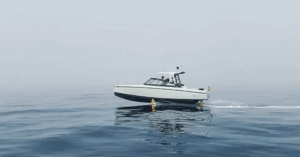
CMA CGM Launches Vietnam’s First 100% Electric River Barge With NIKE
May 29, 2025
PT Bahtera Bahari Shipyard Launches Indonesia’s First All-Electric CBG 500 E Crane
May 29, 2025

Swedish electric boat manufacturer Candela has set a new world record by completing the first-ever intercontinental journey using an electric vessel.
The company’s Candela C-8 Polestar Edition, a high-tech hydrofoil boat, crossed the Strait of Gibraltar this week, traveling from Sotogrande, Spain, to Ceuta, North Africa, in just over one hour.
The 24-nautical mile trip was led by Candela’s CEO Gustav Hasselskog, who piloted the C-8 himself. The journey was carried out in collaboration with Candela’s regional partner Marina Marbella.
After receiving a warm welcome in Ceuta from President-Mayor Juan Jesús Vivas, the boat was recharged and made the return trip to Spain the same day.
One of the most striking features of this journey is that the C-8 runs entirely on electricity—and it literally lifts off the water. Equipped with state-of-the-art hydrofoil technology, the vessel glides above the surface on two submerged, wing-like foils. This greatly reduces drag and helps the boat use 80% less energy than traditional high-speed vessels.
The C-8 used only 40 kilowatt-hours (kWh) of electricity to complete the round trip, costing about €8 in total. On the other hand, the gasoline-powered photo boat that followed along for the voyage consumed 50 liters of petrol, costing around €90. This 90% energy cost reduction is one of the major benefits Candela is highlighting as part of its green transport mission.
The trip also demonstrated how Candela’s technology handles tough sea conditions. The Strait of Gibraltar is known for strong currents, unpredictable winds, and the meeting of Atlantic and Mediterranean waters-all of which can make sailing rough, especially for smaller boats.
But Candela’s hydrofoil system uses onboard sensors that adjust the foils up to 100 times per second, providing a stable and smooth ride. According to the company, passengers on the C-8 didn’t feel the waves at all, while the photo boat bounced around in the choppy waters.
Candela explained that this automated system acts like a flight controller on a modern fighter jet, constantly adjusting to keep the boat steady. The comfortable ride is a major plus for people who suffer from seasickness, offering a much more pleasant experience than traditional boats.
The voyage was part of a larger goal to showcase the capabilities of Candela’s next-generation P-12 electric ferry. The P-12 is the world’s first electric hydrofoil ferry and is already operating in Stockholm’s public transport system. It can carry 30 passengers at high speed, cutting travel time in half while using far less energy than conventional ferries.
The Strait of Gibraltar sees more than 3.5 million crossings each year, mostly handled by large diesel-powered car ferries that connect major hubs. These vessels often leave out smaller coastal towns, making travel inconvenient for local residents.
Candela hopes its technology can help solve this by introducing fast, direct, and sustainable ferry routes that complement existing services and improve access for underserved communities.
The company believes that adding new electric routes won’t just help reduce emissions, it will also open up more affordable and efficient transport options across the Mediterranean. The P-12’s low energy use and smooth ride could be especially helpful along the Spanish coast, such as between cities on the Costa del Sol.
This historic crossing was made possible through a partnership with Avangreen, a clean energy company involved in developing Ceuta’s largest solar plant and other electrification projects. Manuel Gómez, Avangreen’s founder and CEO, joined the voyage and expressed interest in working with Candela to explore new ferry routes in the region.
Candela’s P-12 ferries are already confirmed to operate in other regions including Berlin, Lake Tahoe in the U.S., Saudi Arabia’s NEOM project, and New Zealand.
Reference: Candela Technology
Source: Maritime Shipping News


